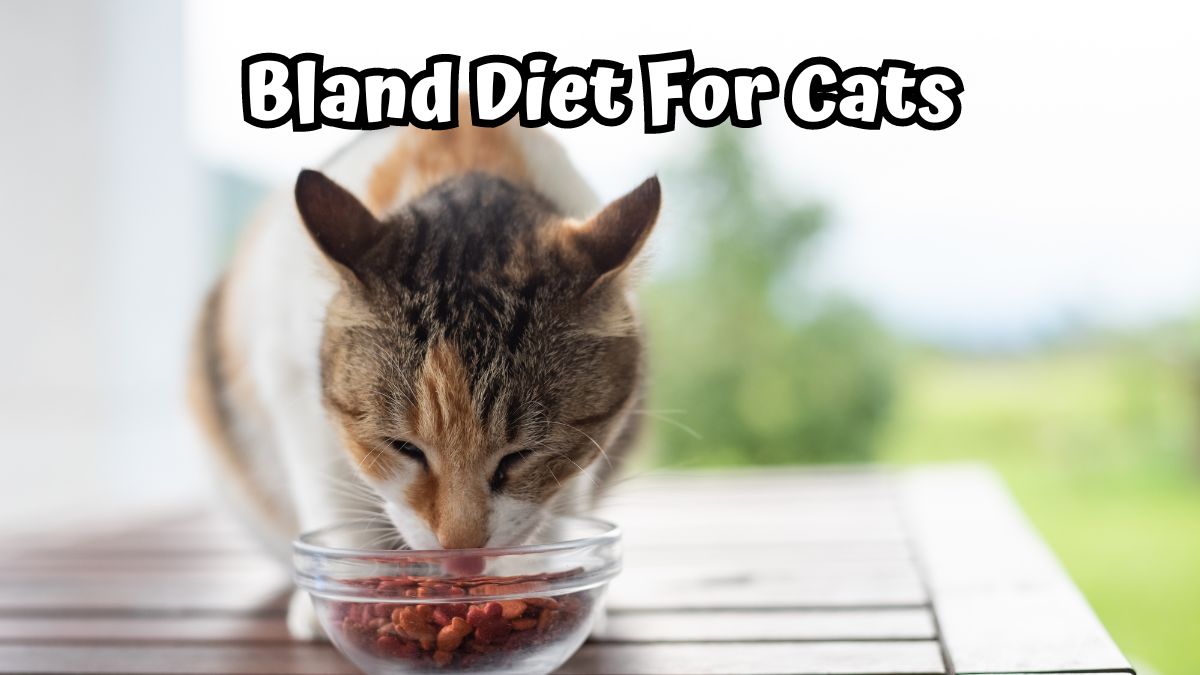When it comes to our feline friends, maintaining a healthy digestive system is paramount. The proper diet can make all the difference, whether due to a temporary upset or a chronic condition.
Enter the concept of a bland diet—a gentle yet practical approach to soothing your cat’s gastrointestinal woes.
This special regimen is tailored to provide easily digestible nourishment, support recovery, and restore normal gut function.
Focusing on boiled lean meats, simple carbohydrates, and necessary hydration, it’s a path to scientifically grounded and lovingly crafted healing.
This article is a comprehensive guide to supporting your cat’s gut health through thoughtful nutrition. It covers everything from identifying when a bland diet is needed to selecting ingredients and adjusting meal portions carefully.
Discover how a bland diet can be crucial in nurturing your cat’s well-being and paving the way for a happy, healthy life.
Understanding a Bland Diet for Cats

A bland diet for cats is specifically designed to soothe the digestive tract and promote the restoration of normal stool consistency during periods of gastrointestinal upset.
Benefits of a Bland Diet for Digestive Health
A bland diet can be critical to their recovery when cats experience digestive issues such as acute diarrhea or chronic diarrhea.
It is composed of easily digestible foods that can help reduce gastrointestinal tract irritation, leading to more formed stools and less frequent loose or watery stools.
This diet typically includes boiled lean meats, simple carbohydrates, and added moisture to ensure hydration, all gentle on the stomach.
Identifying Cases That Require a Bland Diet
A bland diet is often necessary when a cat exhibits signs of an upset stomach, including soft stools or other minor digestive complaints.
However, it is also used in cases of acute illness or following surgery when the digestive system needs to heal.
Veterinarians typically recommend a bland diet when a cat’s digestive tract is compromised and it requires a more soothing nutritional option to regain its digestive health.
Designing a Bland Diet
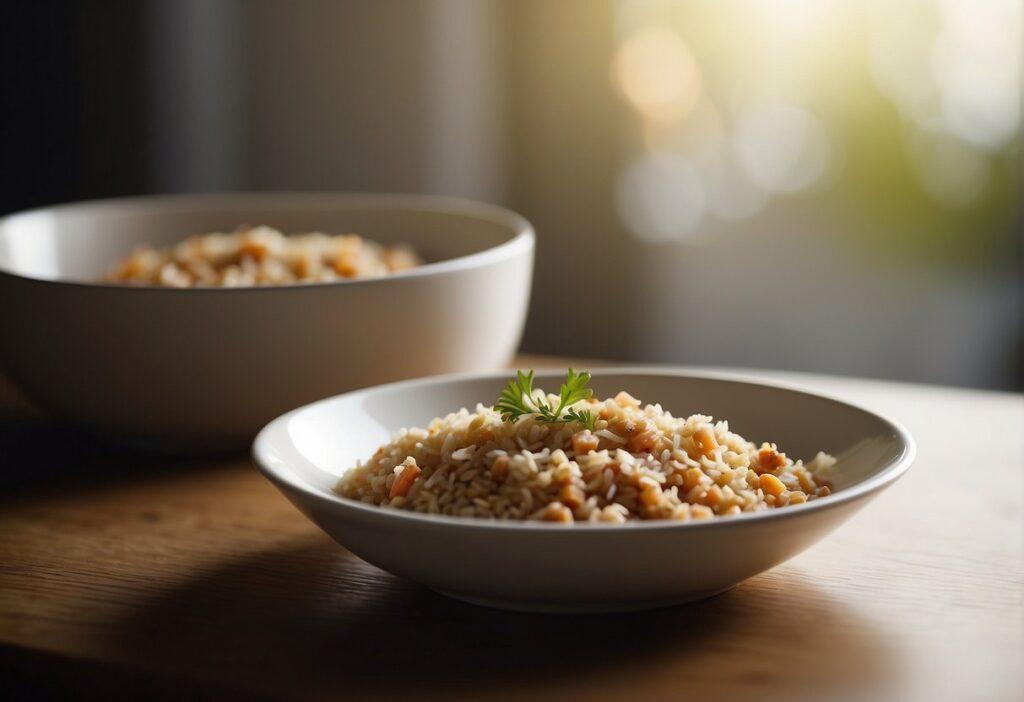
When designing a bland diet for cats, it is imperative to focus on digestible ingredients and appropriate feeding schedules that promote gastrointestinal rest.
Choosing the Right Ingredients
The goal with bland food is to select ingredients that are easy to digest and non-irritating to a cat’s stomach.
White rice is a preferred carbohydrate because it’s plain and low in fiber, which is gentle on the stomach. For protein, plain meat like boiled chicken or turkey, cut into small pieces, is ideal as it is low in fat.
Avoid any seasonings, including salt and garlic, which can harm cats.
Sweet potato can be added in small amounts as a source of vitamins, but its portion should be moderated.
Small amounts of chicken broth, free from onions, garlic, and salt, can be used if additional flavor is needed.
- Carbohydrates: White rice (highly digestible, low in fiber)
- Protein: Boiled chicken or turkey (plain, low in fat, cut into small pieces)
- Vegetables: Sweet potato (in small amounts)
- Flavoring: Chicken broth (no onions, garlic, or salt)
Portion Sizes and Meal Frequency
Cats with upset stomachs should be fed small meals throughout the day to avoid overwhelming their digestive system.
Starting with small amounts is key; typically, the amount should be a fraction of the cat’s regular diet.
Initially, offer these smaller portions every 3-4 hours, observing how the cat responds before giving more.
After 12-24 hours, gradually increase the portion sizes if the cat tolerates the food well.
- Initial portion size: Small amounts of bland diet every 3-4 hours
- Observation period: 12-24 hours before increasing portions
Transitioning from Bland Diet Back to Regular Diet
Transitioning back to the cat’s usual food should be a small-step process to prevent any sudden change that could upset the stomach.
Begin by introducing small pieces of the cat’s regular pet food into the bland diet over 2-3 days, increasing the regular food proportionally while decreasing the bland diet.
During this time, monitor for any signs of food allergies or digestive upset.
Supplementing with omega fatty acids or vitamin E can aid in restoring skin and coat health, which may have been affected by diet change.
- Day 1-3 of transition: Mix regular food in small pieces with the bland diet, gradually increasing the regular food amount
- Supplementation: Add fatty acids or a vitamin E supplement to promote coat health during the transition
Critical Nutritional Components
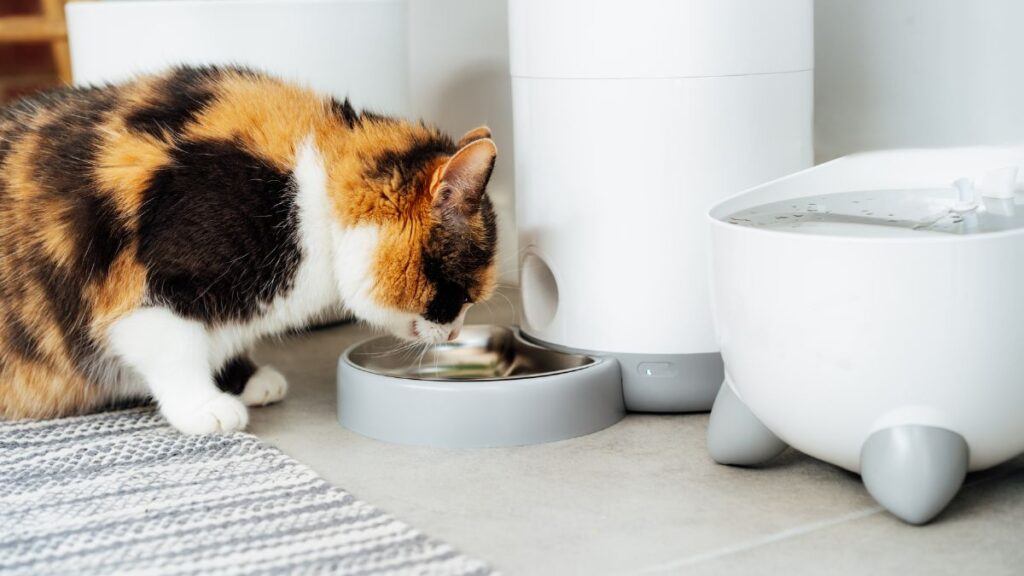
When considering a bland diet for cats, vital nutrients are crucial to maintaining their well-being. A blend of vitamins, minerals, proteins, and fats supports their health.
Vitamins and Minerals in a Bland Diet
Vitamins and minerals play a fundamental role in a cat’s health.
Specifically, B vitamins like thiamine mononitrate and pyridoxine hydrochloride are essential for energy metabolism and nerve function.
Minerals such as zinc sulfate, copper sulfate, ferrous sulfate, and manganese sulfate ensure proper enzymatic reactions and support a strong immune system.
Potassium iodide is necessary for thyroid health, while sodium selenite is crucial for antioxidant protection and immune function.
Folic acid aids in amino acid metabolism and the formation of red blood cells.
Table 1: Essential Vitamins and Minerals
| Nutrient | Role in Feline Health |
|---|---|
| Thiamine mononitrate (B1) | Supports energy metabolism |
| Pyridoxine hydrochloride (B6) | Important for protein metabolism |
| Folic acid | Aids in amino acid metabolism |
| Zinc sulfate | Vital for skin and immune health |
| Copper sulfate | Necessary for iron metabolism |
| Ferrous sulfate | Supports hemoglobin formation |
| Potassium iodide | Essential for thyroid function |
| Manganese sulfate | Crucial for bone development |
| Sodium selenite | Acts as an antioxidant |
Proteins and Fats for a Balanced Diet
Proteins are the building blocks of a healthy cat diet, providing essential amino acids that support tissue repair and muscle growth.
A bland diet must contain high-quality protein sources to maintain bodily functions without overworking the digestive system.
Fats are equally important, offering energy and aiding in absorbing fat-soluble vitamins such as vitamin D.
Balancing these macronutrients is key to supporting a cat’s energy needs and overall health.
Note: Always consult a veterinarian for the best dietary balance for your cat’s health requirements.
Special Considerations for Dietary Sensitivities
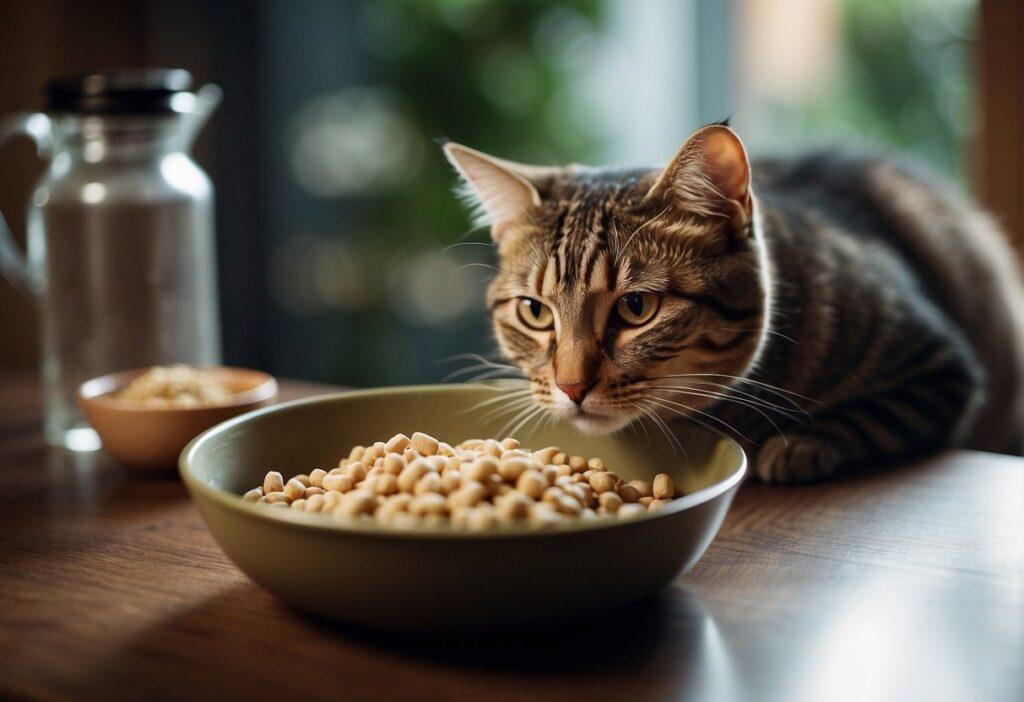
Cats with dietary sensitivities require carefully tailored diets to manage their health effectively. These diets should minimize adverse food reactions and support overall well-being.
Managing Food Allergies and Intolerances
Cats can develop allergies or intolerances to certain ingredients in their diet, leading to symptoms like itching or gastrointestinal upset.
A bland diet for cat allergies should eliminate common allergens and focus on a single protein source.
This restricts the variety of ingredients and helps to pinpoint the exact cause of the allergic reaction.
- Single Protein Source diets include:
- Chicken
- Turkey
- Fish
The GI system can be delicate, and a restricted diet’s bland recipe may help reduce inflammation and promote healing.
For instance, including easily digestible foods like cottage cheese can soothe the GI tract while providing essential nutrients.
Supporting Cats with Chronic Conditions
Adult cats with chronic conditions such as inflammatory bowel or kidney disease may benefit from a bland diet.
This diet should contain low levels of phosphorus and moderate protein to support healthy aging and kidney function.
- Suitable bland diet characteristics for chronic conditions:
- Low Phosphorus: Essential for cats with kidney issues.
- Moderate Protein: High-quality protein in controlled amounts.
A bland diet and an appropriate treatment plan are critical for managing these health issues.
The goal is to maintain a balance that supports their GI system without exacerbating their chronic condition.
Monitoring and Adjusting the Bland Diet Plan
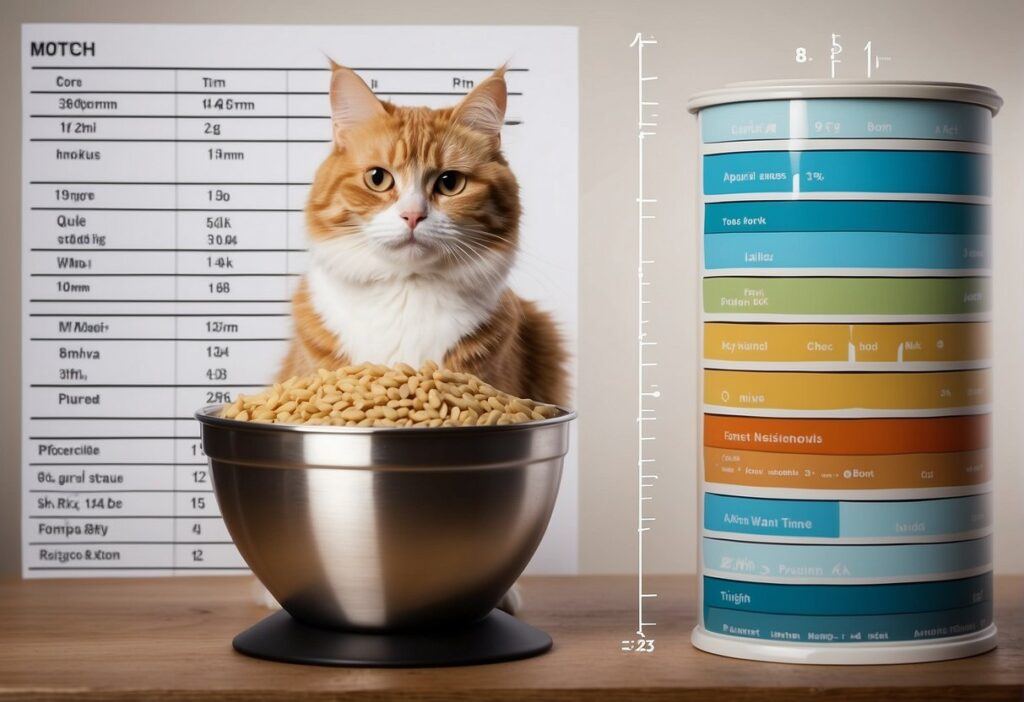
Pet owners should closely observe their cat’s response to a bland diet and continuously assess whether adjustments or veterinary consultation are needed.
Evaluating Cat’s Response to the Diet
Initial Observation: Monitor the cat after introducing the bland diet. Look for signs of improvement in bouts of diarrhea or signs of intestinal upset.
If the cat’s condition improves, gradually reintroduce its regular diet.
- Day-by-Day Tracking: Keep a daily log of the cat’s:
- Appetite
- Stool consistency
- Energy levels
- Overall behavior
Adjusting the Diet: Should the cat not respond positively within a few days, consider altering the meal plan, such as changing the protein source in bland meals or adjusting portion sizes.
When to Consult a Veterinarian
Lack of Improvement: Consult a veterinarian if the cat does not improve after 2-3 days on a bland diet or exhibits severe symptoms.
- Severe Cases: A prompt veterinary visit is mandatory in cases of persistent diarrhea or other severe symptoms. They may perform diagnostic tests or physical exams.
Expert Diet advice: Veterinarians can guide you in transitioning from bland meals to a regular diet. They may also recommend specific cat food company products better suited for a sensitive stomach.
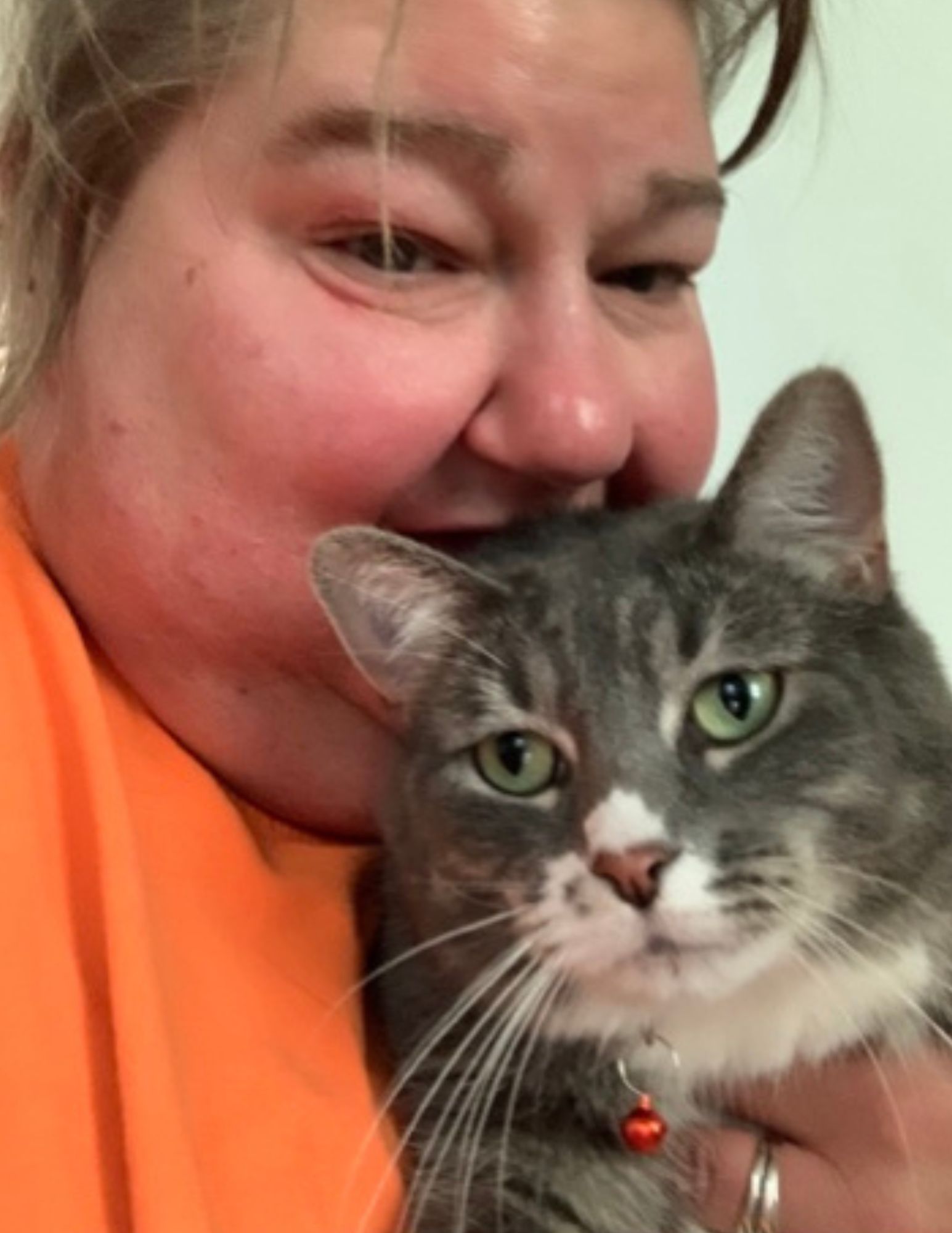
Meet Ann Haasnoot, the passionate founder of CatFurLife.com. A lifelong cat lover from Wisconsin, Ann combines her extensive feline behavior and care knowledge with her love for writing. On her website, she shares invaluable insights about cat breeds, care tips, and her experiences with her beloved furbaby, aiming to deepen the bond between cats and their human companions.

